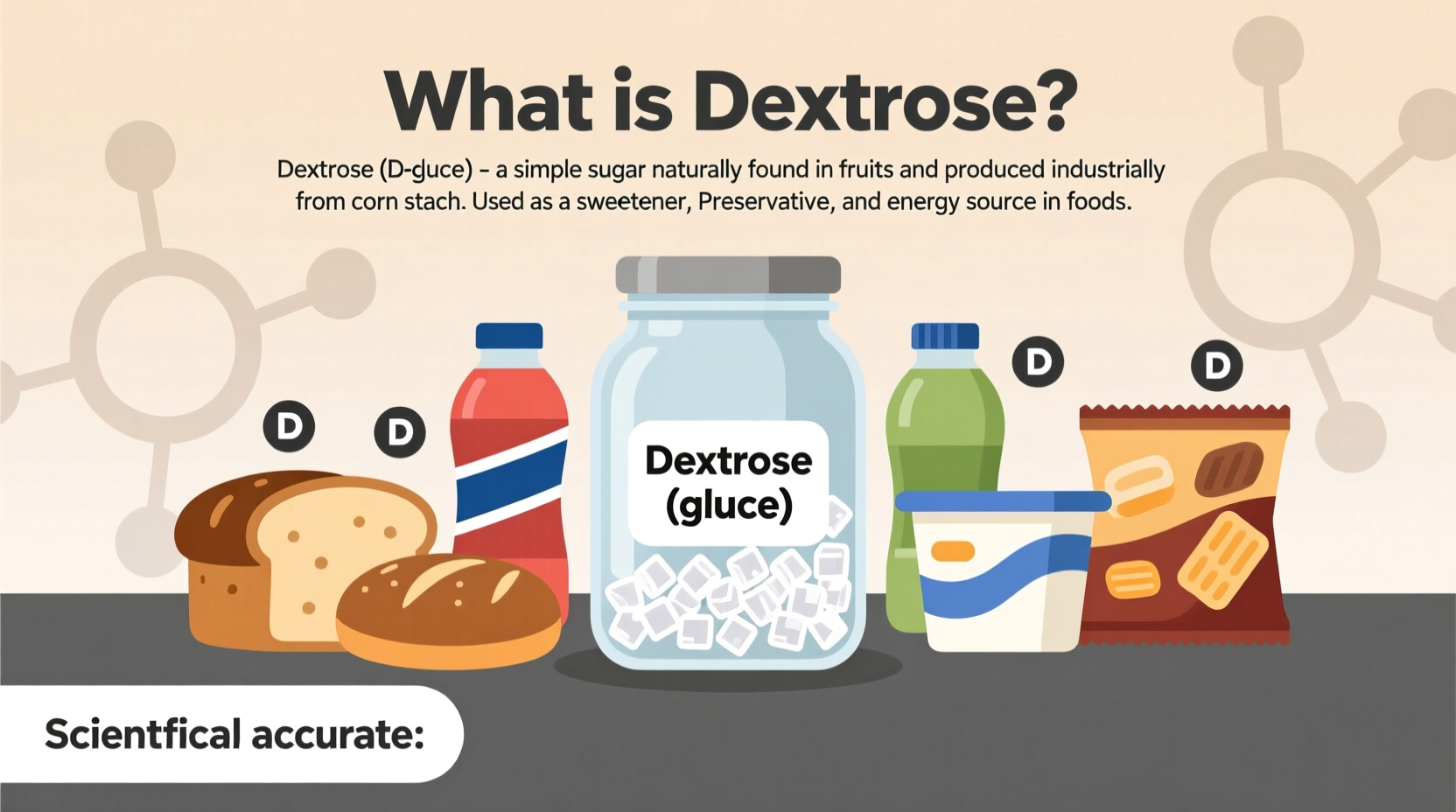What Exactly Is Dextrose and Why Should You Care?
When you see "dextrose" listed on a food label, you're looking at pure glucose - the fundamental sugar molecule that powers your cells. Unlike table sugar (sucrose), which contains both glucose and fructose, dextrose consists of single glucose molecules that your body can immediately use for energy. Food manufacturers favor dextrose because it's less sweet than sucrose but provides consistent browning in baked goods and helps maintain texture in processed foods.
Contrary to what some believe, dextrose isn't just an artificial additive. It occurs naturally in corn, grapes, and other plants, though commercial food production typically derives it from corn starch through enzymatic processing. The U.S. Food and Drug Administration classifies dextrose as a "sugar" rather than an artificial sweetener, requiring its inclusion in total sugar counts on nutrition labels.
How Dextrose Functions in Your Favorite Foods
Food scientists utilize dextrose for specific technical properties beyond just sweetness. Its relatively low sweetness level (about 70-80% as sweet as table sugar) makes it ideal when manufacturers want subtle sweetness without overpowering other flavors. In bread production, dextrose feeds yeast during fermentation, creating better rise and crust color. In frozen desserts, it lowers the freezing point, preventing ice crystals and creating smoother texture.
| Sweetener | Sweetness Level (vs Sucrose) | Primary Food Applications | Glycemic Index |
|---|---|---|---|
| Dextrose (Glucose) | 70-80% | Baked goods, sports drinks, processed meats | 100 |
| Sucrose (Table Sugar) | 100% | General sweetening, preserves, beverages | 65 |
| Fructose | 120-170% | Beverages, dairy products, processed foods | 15-25 |
| High Fructose Corn Syrup | 100% | Soft drinks, processed foods, condiments | 87 |
Tracking Dextrose in Your Daily Diet
You'll find dextrose in unexpected places beyond just sweets. Check labels on salad dressings, cured meats, instant soups, and even some "sugar-free" products where it serves as a bulking agent. The USDA FoodData Central database shows that a single serving of commercial barbecue sauce often contains 5-8 grams of dextrose, while many protein bars use it to improve texture without excessive sweetness.
For people monitoring blood sugar, understanding dextrose matters significantly. Because it's pure glucose, dextrose raises blood sugar faster than sucrose or fructose. The American Diabetes Association notes that dextrose is sometimes used in emergency glucose tablets specifically because of its rapid absorption. If you have diabetes, tracking dextrose becomes crucial since it directly impacts your blood glucose levels more immediately than other sweeteners.

Practical Guidance for Consumers
When evaluating foods containing dextrose, consider these practical factors:
- Context matters: A small amount in whole-grain bread contributes to fermentation and browning without significant sugar impact
- Quantity counts: Check serving sizes - 2g per serving differs greatly from 10g per serving
- Processing level: Dextrose in minimally processed foods (like some dried fruits) differs from highly processed items
- Overall nutritional profile: Don't judge a food solely on dextrose content but consider fiber, protein, and other nutrients
For home cooks, dextrose serves specific purposes that regular sugar can't replicate. Professional bakers use it in small amounts (typically 1-3% of flour weight) to enhance crust color in breads without increasing sweetness. In ice cream making, it prevents excessive crystallization. When substituting in recipes, use 0.8 cups dextrose for every 1 cup of sucrose, recognizing that flavor and texture will differ slightly.
Dextrose Through the Years: A Brief Timeline
The use of dextrose in food has evolved significantly:
- 1800s: German chemist Andreas Marggraf first isolated glucose from raisins, naming it "dextrose" due to its rightward optical rotation
- 1920s: Industrial production from corn starch began in the United States, creating a stable sweetener alternative during sugar shortages
- 1950s: Food manufacturers discovered dextrose's functional properties beyond sweetness, incorporating it into processed meats and baked goods
- 1970s: High fructose corn syrup development reduced dextrose usage in beverages but expanded its role in specialty food applications
- 2000s-Present: Growing awareness of sugar content has led to both reduced usage in some products and increased transparency in labeling
Making Informed Choices About Dextrose
Understanding dextrose empowers you to make smarter food choices without unnecessary fear. While excessive added sugar of any type warrants caution, dextrose itself isn't inherently harmful - it's how much you consume and in what context. The Dietary Guidelines for Americans recommend limiting added sugars to less than 10% of daily calories, which includes dextrose. For most adults, this means staying under 50 grams of total added sugars daily.
When reading labels, remember that "dextrose" appears among the first ingredients only in products where it serves a primary sweetening function. If it appears near the end of the list, it's likely present in small amounts for functional purposes rather than significant sweetness. This distinction helps you evaluate whether a product's dextrose content meaningfully impacts your dietary goals.
Frequently Asked Questions
Is dextrose the same as regular sugar?
No, dextrose (glucose) differs from regular table sugar (sucrose). Sucrose contains both glucose and fructose molecules, while dextrose is pure glucose. Dextrose is less sweet than sucrose but affects blood sugar more directly.
Why do food companies use dextrose instead of regular sugar?
Food manufacturers choose dextrose for specific technical reasons: it provides consistent browning in baked goods, enhances texture in processed foods, feeds yeast in bread making, and has different crystallization properties than sucrose. It's also often more cost-effective than sucrose.
Is dextrose bad for people with diabetes?
Dextrose affects blood sugar more rapidly than sucrose since it's pure glucose. People with diabetes should account for dextrose in their carbohydrate counting, recognizing that it causes quicker blood sugar spikes. However, in controlled amounts as part of balanced meals, it can be included in diabetic meal plans.
Can I replace dextrose with regular sugar in recipes?
You can substitute with adjustments: use 0.8 cups dextrose for every 1 cup of sucrose. However, recognize that dextrose provides different functional properties - it won't caramelize the same way and affects texture differently, particularly in baking and frozen desserts.











 浙公网安备
33010002000092号
浙公网安备
33010002000092号 浙B2-20120091-4
浙B2-20120091-4